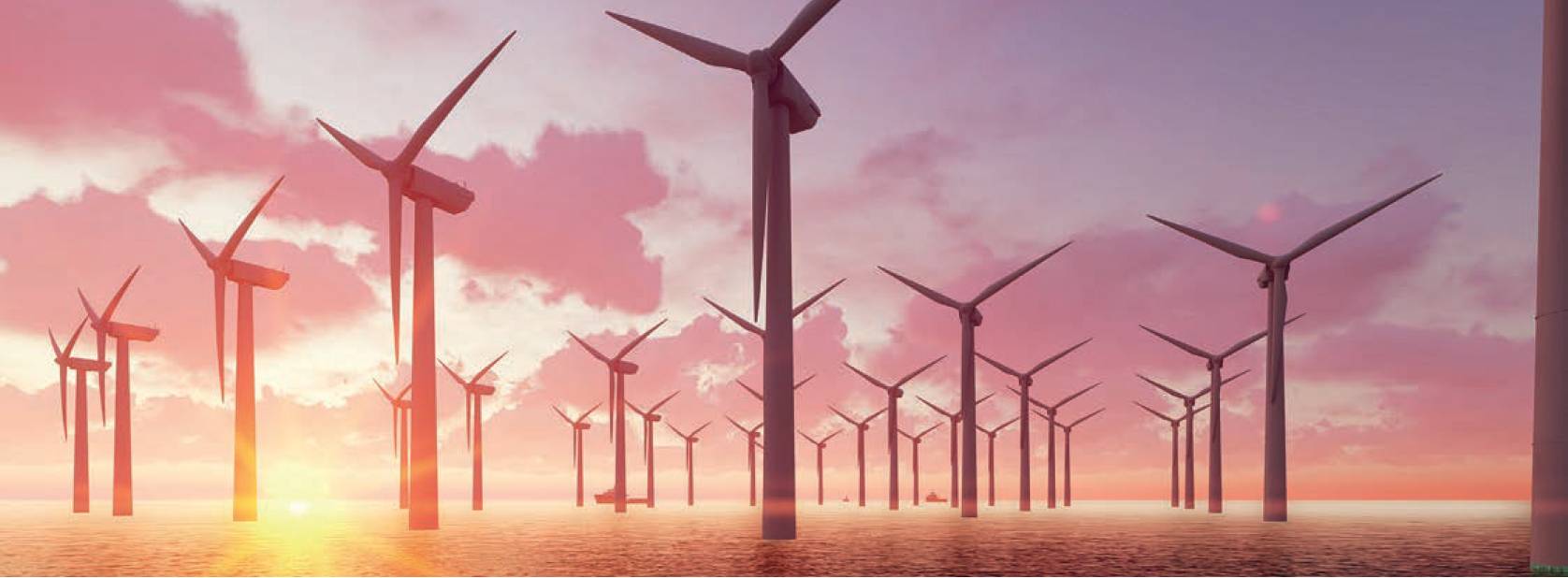The wind of change is blowing on renewables
Mark Coates, International Director of Public Policy and Advocacy, and Chris Mills, Enterprise Account Manager – Northern Europe, Bentley Systems

LATELY, renewable energy in the United Kingdom has become a success story. In the second quarter of 2022, nearly two- fifths (38.6%) of the UK’s electricity was generated by renewables. Total renewable capacity rose by 6.5% year-over-year and in two of the last three quarters, the UK has generated more electricity from renewables than from fossil fuels.
Wind – particularly offshore wind – has been a major driving force. The UK is fortunate with both its climate and geography; the shallow waters of the North Sea, and the high winds that blow through the area, make it one of the world’s best sites for siting turbines. However, the UK has also moved quickly to exploit those advantages. Last summer, the world’s largest offshore windfarm, Hornsea Two, became fully operational. The 1.3-gigawatt farm has a total of 165 wind turbines located roughly 90km off the Yorkshire coast. It sits alongside its predecessor, Hornsea One, which is now the world’s second biggest windfarm. Together, the two facilities can power 2.5 million homes. Another 100-turbine mega-farm, East Moray, opened during the first quarter of 2022 in the seas off North East Scotland. Further projects at Dogger Bank and Berwick Bank will soon follow.
Wind, more than any other renewable, offers the UK government the best hope of hitting its target of decarbonising all electricity generation by 2035. It cannot work in isolation, though, as new nuclear facilities will contribute. Additionally, biopower, hydropower, and solar power remain a significant part of the overall mix. However, wind offers the biggest potential gains. Those gains can come quickly; in 2010, the UK generated more energy from hydro than from offshore wind. By 2020, the amount coming from offshore wind was six times greater than from hydro. Only China produces more energy from offshore wind and until 2021, the UK was even ahead of China.
The rapid growth in offshore wind is partly due to government policy. Contracts for projects come with strict deadlines, and a competitive auction process drives down costs. The new UK prime minister, Rishi Sunak, has promised to build 50 gigawatts of offshore wind by 2030. However, significant medium-term challenges remain. In particular, the UK’s electricity grid needs to be expanded and adapted to make it truly fit for the new generation. In the longer term, highly polluting industries that do not currently run on electricity, such as transport and domestic and commercial heating, will need to make the switch if the UK is to meet its overall environmental commitments.
What other countries can learn from the UK’s success

The International Energy Agency has issued several predictions of how much solar and wind energy production will grow over the next 30 years. Its model of rapid growth, followed by plateau keeps being proven wrong. Growth has continued, and it is partly because decisions about where to invest in different types of renewable technology, where individual countries have placed their bets, have been much smarter than most modelling can account for. The other reason is the speed at which technology is improving and prices are coming down.
A recent report by the Chalmers University of Technology in Gothenburg, Sweden warned of the dangers of taking too much comfort from the performance of the UK. Researchers found that the average annual growth rate in the UK from wind and solar between 2015-2020 was 3% of total supply.
If every country matched that over the next two decades, they added, global warming could be limited to below 1.5ºC. However, landlocked countries, and those with deep waters off their coasts, cannot rely on offshore wind power in the same way. That means that to achieve climate targets, every country in the world should develop solar and onshore wind about two to three times faster than the UK, it concluded. However, since most countries lack the UK’s geographic advantages, they need to identify advantages and aggressively exploit them.
These countries are aware of this situation and are targeting investment elsewhere. For example, the United States has invested heavily in solar power and hydropower, as well as onshore wind. It is also shortening supply chains and encouraging industries to move from fossil fuels to electricity, such as through the research and development of electric vehicles.
The investment is not about producing more of the same thing, but rather at making renewable technology better, more efficient, and cheaper to deploy and run.
Applying lessons learned in the industry
The industry has made huge strides in areas such as energy storage. Large high-capacity battery farms are helping solve a key problem of renewables, which is that they can produce too much energy when you don’t need it, and too little when you do. There are two so-called ‘laws’ that are said to apply to technology.
It is easy to over-rely on technology when facing enormous, complex global challenges, such as the need to end our reliance on fossil fuels.One is Moore’s Law, which states that technology becomes about twice as effective every two years.
The other is Wright’s Law, which says that each time you double production of a technology, its cost drops by a constant percentage. Recently, a team from the University of Oxford looked at the evidence and tried to work out whether these laws applied to the energy transition
. They found that the laws did not fit the evidence for nuclear very well, as it has actually become three times more expensive since it was first used in the 1950s. But for solar and wind, they found the laws were an excellent fit. The price of solar has fallen by a cost factor of 5,000 since 1958. In terms of offshore wind, energy costs dropped from £120/MWh in 2015 to less than £40/MWh today. The researchers concluded that under a fast transition to renewables, we could stop using fossil fuels within 20 to 25 years.
How technology can help
It is easy to over-rely on technology when facing enormous, complex global challenges, such as the need to end our reliance on fossil fuels. The various ‘moonshot’ projects to filter carbon from ambient air on a vast scale, using direct air capture (DAC), have an obvious appeal. However, there is no guarantee that the technical problems will be solved. DAC is currently very expensive and requires an enormous amount of energy.
Equally, though, it is important not to underestimate the role of technological improvements in mitigating climate change and driving the world to a cleaner future. In difficult financial circumstances, it is vital that we continue to invest in research and development around clean energy, as well as new infrastructure and hardware. It won’t be solely solar, or wind, or biomass, or energy capture, or hydrogen, or ‘small’ nuclear that gets us to net zero.
And it won’t be just behavioural change, or huge new renewable energy plans, or great scientific breakthroughs. This is the challenge of our lifetime, and we are going to need to deploy of all these solutions together to succeed.
Mark Coates, International Director of Public Policy and Advocacy, and Chris Mills, Enterprise Account Manager – Northern Europe, Bentley Systems